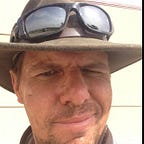Petroglyphs on the Mesa
My introduction to Digital Heritage at Cowhead Mesa
My interest in digital heritage began with the 2007 field season. This was my first year as field manager for the Lubbock Lake Landmark regional research program. One goal for the summer was recording a series of petroglyphs at Cowhead Mesa, located along the eastern escarpment breaks of northwest, Texas.
Petroglyphs are a type of rock art in which the rock is engraved rather than painted.
Rock art sites in this region are rare, and this provided an important opportunity to gain insights into historic Native American and early historic ranching interactions with the landscape.
The petroglyphs along the mesa consisted of one large panel stretching ~21 meters and nine smaller panels. Hundreds of petroglyphs were etched into the main panel, and many of these above our heads. The initial plan was to hand draw the petroglyphs on the main panel using some string grid to accurately map each petroglyph. The problem with this traditional type of recording was that the side of the mesa was not flat and sketching from different viewpoints would produce inaccuracies. Another problem with hand drawing was that depending upon the time of day and how the light reveals the petroglyphs different people will see different things making it difficult to produce one map that fully and accurately documents the rock art.
The research team at the Landmark searched for other solutions to record the petroglyphs. I remember doing a Google…
